Self-Reflection: Personality Characteristics and Workplace Performance
VerifiedAdded on 2023/01/16
|9
|2340
|52
Essay
AI Summary
This essay provides a self-reflection on personality characteristics and their influence on workplace behavior, incorporating self-assessment surveys. The introduction highlights the significance of self-assessment in predicting workplace behavior and outlines the essay's objectives, which include reviewing literature on personality and emotions in the workplace, evaluating personality measures, and demonstrating self-awareness through a self-assessment survey. The literature review explores the roles of personality and emotions in organizational communication, creativity, teamwork, and leadership. It then evaluates the Big Five Personality test and the Myers-Briggs personality theory as self-assessment tools. The essay details the student's self-assessment results using the Big Five Personality test, including scores for positive and negative emotions, cognitive reappraisals, and personality traits such as extraversion, agreeableness, conscientiousness, neuroticism, and openness. It also includes results from a Jungian personality type assessment. The analysis interprets these results, relating them to the student's strengths, weaknesses, and potential workplace behaviors. The essay concludes by summarizing the key arguments on the implementation of personality traits in the workplace, emphasizing how these traits influence work behavior, job satisfaction, teamwork, and leadership potential. It underscores the importance of understanding these traits for personal and professional development.
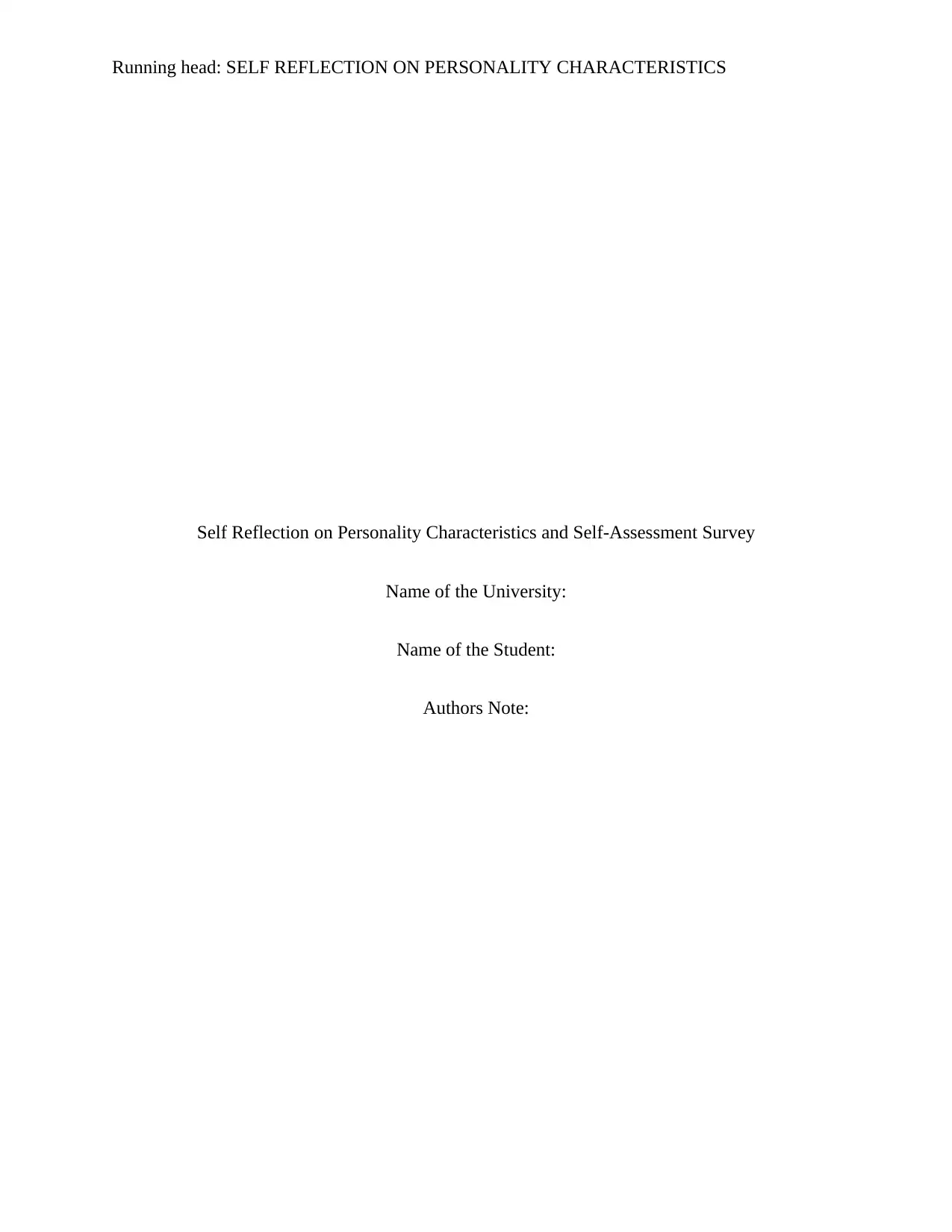
Running head: SELF REFLECTION ON PERSONALITY CHARACTERISTICS
Self Reflection on Personality Characteristics and Self-Assessment Survey
Name of the University:
Name of the Student:
Authors Note:
Self Reflection on Personality Characteristics and Self-Assessment Survey
Name of the University:
Name of the Student:
Authors Note:
Paraphrase This Document
Need a fresh take? Get an instant paraphrase of this document with our AI Paraphraser
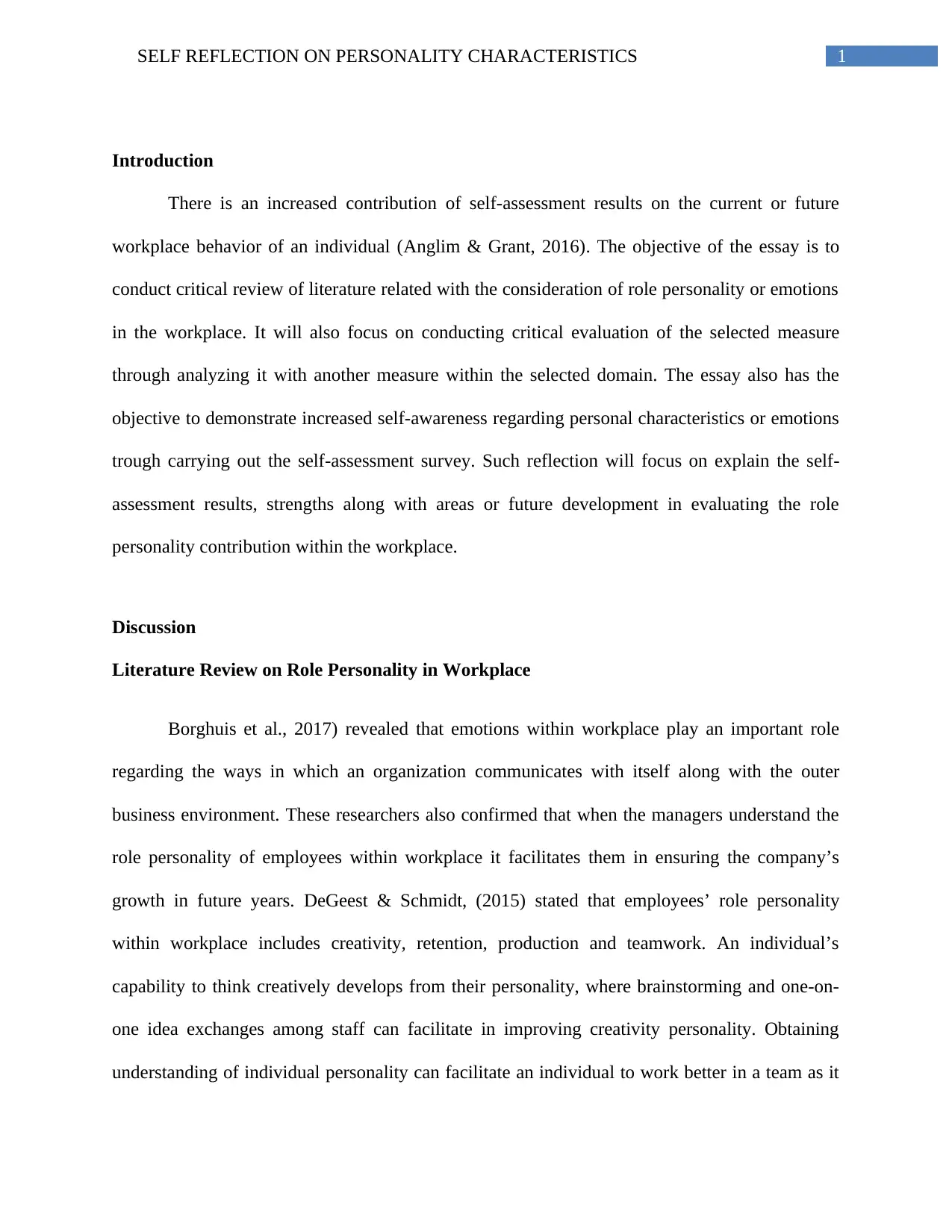
1SELF REFLECTION ON PERSONALITY CHARACTERISTICS
Introduction
There is an increased contribution of self-assessment results on the current or future
workplace behavior of an individual (Anglim & Grant, 2016). The objective of the essay is to
conduct critical review of literature related with the consideration of role personality or emotions
in the workplace. It will also focus on conducting critical evaluation of the selected measure
through analyzing it with another measure within the selected domain. The essay also has the
objective to demonstrate increased self-awareness regarding personal characteristics or emotions
trough carrying out the self-assessment survey. Such reflection will focus on explain the self-
assessment results, strengths along with areas or future development in evaluating the role
personality contribution within the workplace.
Discussion
Literature Review on Role Personality in Workplace
Borghuis et al., 2017) revealed that emotions within workplace play an important role
regarding the ways in which an organization communicates with itself along with the outer
business environment. These researchers also confirmed that when the managers understand the
role personality of employees within workplace it facilitates them in ensuring the company’s
growth in future years. DeGeest & Schmidt, (2015) stated that employees’ role personality
within workplace includes creativity, retention, production and teamwork. An individual’s
capability to think creatively develops from their personality, where brainstorming and one-on-
one idea exchanges among staff can facilitate in improving creativity personality. Obtaining
understanding of individual personality can facilitate an individual to work better in a team as it
Introduction
There is an increased contribution of self-assessment results on the current or future
workplace behavior of an individual (Anglim & Grant, 2016). The objective of the essay is to
conduct critical review of literature related with the consideration of role personality or emotions
in the workplace. It will also focus on conducting critical evaluation of the selected measure
through analyzing it with another measure within the selected domain. The essay also has the
objective to demonstrate increased self-awareness regarding personal characteristics or emotions
trough carrying out the self-assessment survey. Such reflection will focus on explain the self-
assessment results, strengths along with areas or future development in evaluating the role
personality contribution within the workplace.
Discussion
Literature Review on Role Personality in Workplace
Borghuis et al., 2017) revealed that emotions within workplace play an important role
regarding the ways in which an organization communicates with itself along with the outer
business environment. These researchers also confirmed that when the managers understand the
role personality of employees within workplace it facilitates them in ensuring the company’s
growth in future years. DeGeest & Schmidt, (2015) stated that employees’ role personality
within workplace includes creativity, retention, production and teamwork. An individual’s
capability to think creatively develops from their personality, where brainstorming and one-on-
one idea exchanges among staff can facilitate in improving creativity personality. Obtaining
understanding of individual personality can facilitate an individual to work better in a team as it
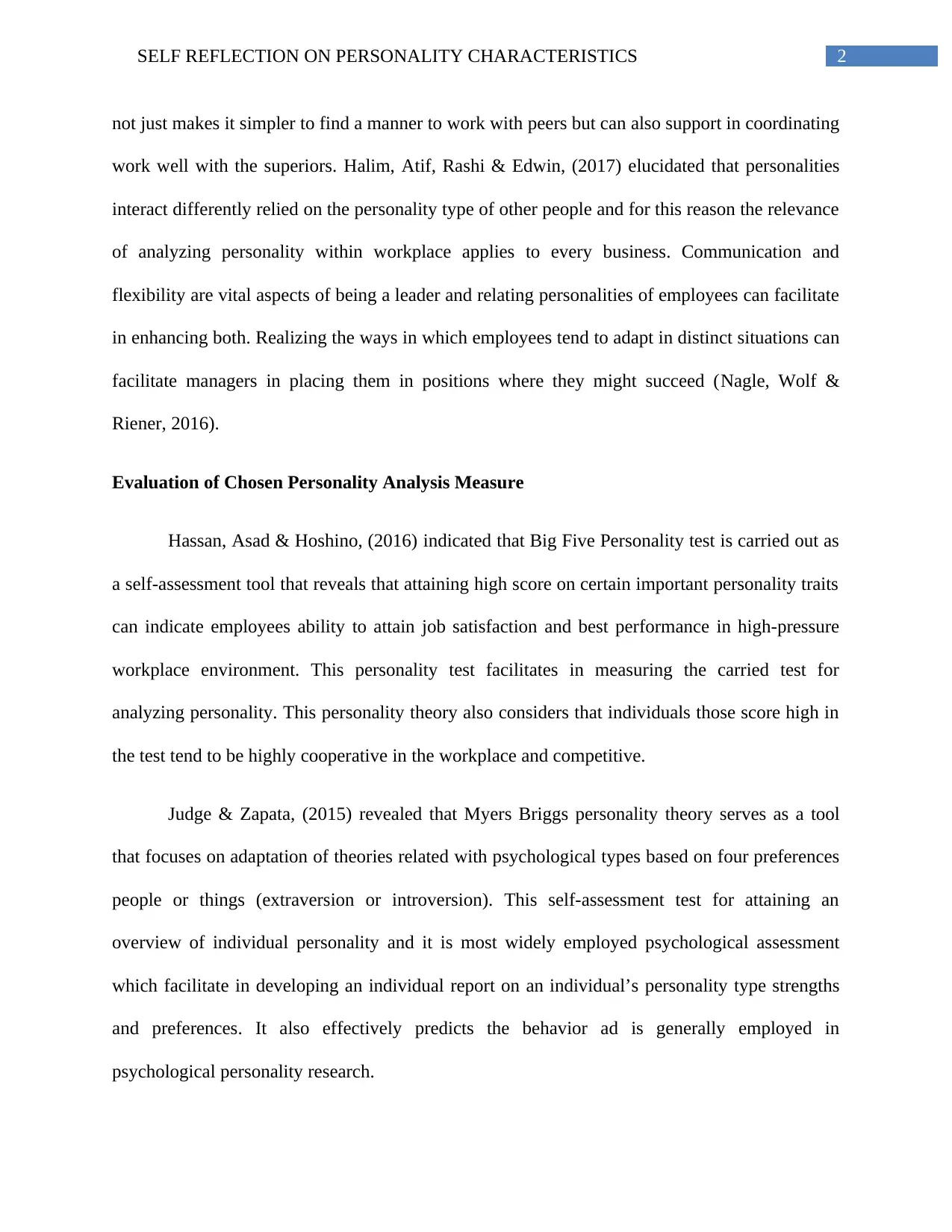
2SELF REFLECTION ON PERSONALITY CHARACTERISTICS
not just makes it simpler to find a manner to work with peers but can also support in coordinating
work well with the superiors. Halim, Atif, Rashi & Edwin, (2017) elucidated that personalities
interact differently relied on the personality type of other people and for this reason the relevance
of analyzing personality within workplace applies to every business. Communication and
flexibility are vital aspects of being a leader and relating personalities of employees can facilitate
in enhancing both. Realizing the ways in which employees tend to adapt in distinct situations can
facilitate managers in placing them in positions where they might succeed (Nagle, Wolf &
Riener, 2016).
Evaluation of Chosen Personality Analysis Measure
Hassan, Asad & Hoshino, (2016) indicated that Big Five Personality test is carried out as
a self-assessment tool that reveals that attaining high score on certain important personality traits
can indicate employees ability to attain job satisfaction and best performance in high-pressure
workplace environment. This personality test facilitates in measuring the carried test for
analyzing personality. This personality theory also considers that individuals those score high in
the test tend to be highly cooperative in the workplace and competitive.
Judge & Zapata, (2015) revealed that Myers Briggs personality theory serves as a tool
that focuses on adaptation of theories related with psychological types based on four preferences
people or things (extraversion or introversion). This self-assessment test for attaining an
overview of individual personality and it is most widely employed psychological assessment
which facilitate in developing an individual report on an individual’s personality type strengths
and preferences. It also effectively predicts the behavior ad is generally employed in
psychological personality research.
not just makes it simpler to find a manner to work with peers but can also support in coordinating
work well with the superiors. Halim, Atif, Rashi & Edwin, (2017) elucidated that personalities
interact differently relied on the personality type of other people and for this reason the relevance
of analyzing personality within workplace applies to every business. Communication and
flexibility are vital aspects of being a leader and relating personalities of employees can facilitate
in enhancing both. Realizing the ways in which employees tend to adapt in distinct situations can
facilitate managers in placing them in positions where they might succeed (Nagle, Wolf &
Riener, 2016).
Evaluation of Chosen Personality Analysis Measure
Hassan, Asad & Hoshino, (2016) indicated that Big Five Personality test is carried out as
a self-assessment tool that reveals that attaining high score on certain important personality traits
can indicate employees ability to attain job satisfaction and best performance in high-pressure
workplace environment. This personality test facilitates in measuring the carried test for
analyzing personality. This personality theory also considers that individuals those score high in
the test tend to be highly cooperative in the workplace and competitive.
Judge & Zapata, (2015) revealed that Myers Briggs personality theory serves as a tool
that focuses on adaptation of theories related with psychological types based on four preferences
people or things (extraversion or introversion). This self-assessment test for attaining an
overview of individual personality and it is most widely employed psychological assessment
which facilitate in developing an individual report on an individual’s personality type strengths
and preferences. It also effectively predicts the behavior ad is generally employed in
psychological personality research.
⊘ This is a preview!⊘
Do you want full access?
Subscribe today to unlock all pages.

Trusted by 1+ million students worldwide
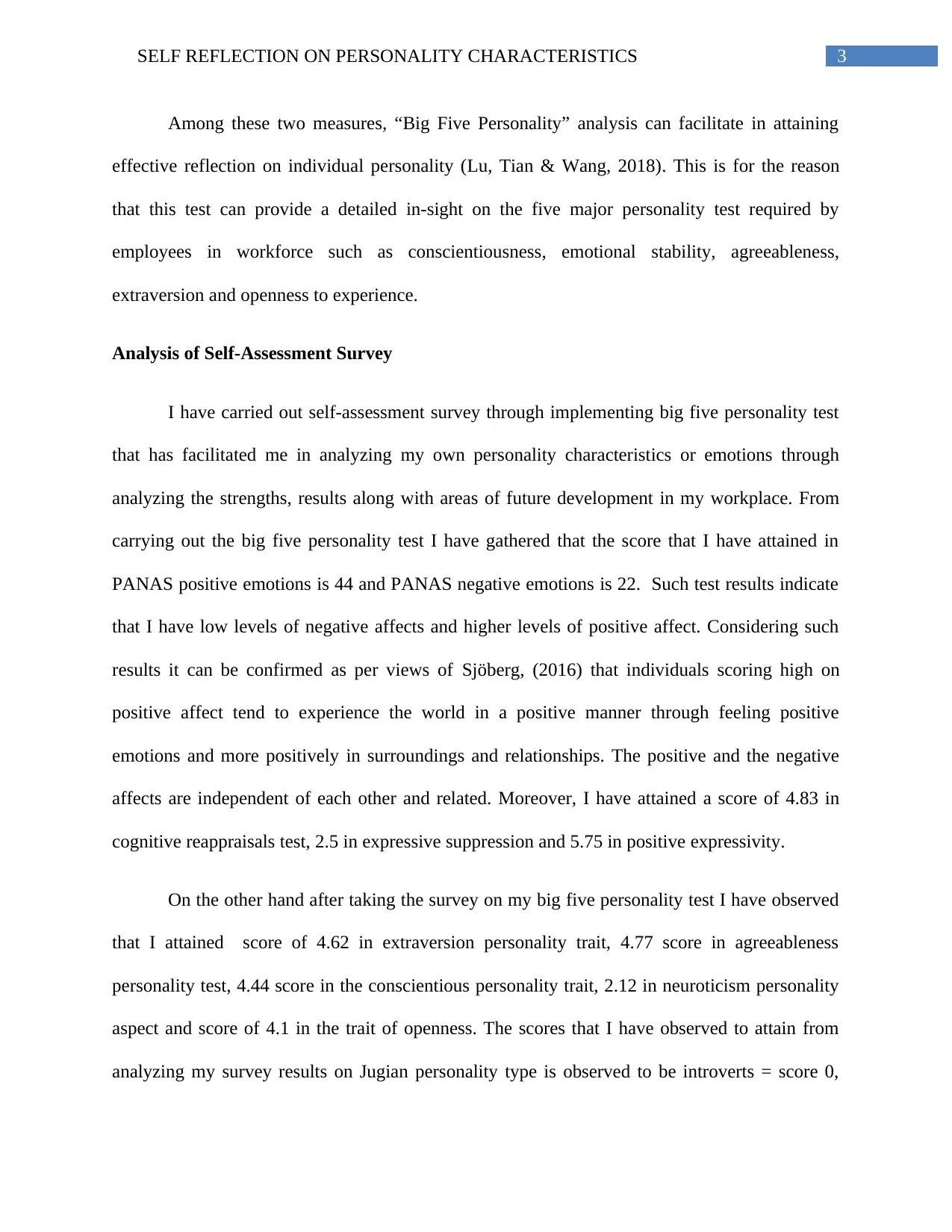
3SELF REFLECTION ON PERSONALITY CHARACTERISTICS
Among these two measures, “Big Five Personality” analysis can facilitate in attaining
effective reflection on individual personality (Lu, Tian & Wang, 2018). This is for the reason
that this test can provide a detailed in-sight on the five major personality test required by
employees in workforce such as conscientiousness, emotional stability, agreeableness,
extraversion and openness to experience.
Analysis of Self-Assessment Survey
I have carried out self-assessment survey through implementing big five personality test
that has facilitated me in analyzing my own personality characteristics or emotions through
analyzing the strengths, results along with areas of future development in my workplace. From
carrying out the big five personality test I have gathered that the score that I have attained in
PANAS positive emotions is 44 and PANAS negative emotions is 22. Such test results indicate
that I have low levels of negative affects and higher levels of positive affect. Considering such
results it can be confirmed as per views of Sjöberg, (2016) that individuals scoring high on
positive affect tend to experience the world in a positive manner through feeling positive
emotions and more positively in surroundings and relationships. The positive and the negative
affects are independent of each other and related. Moreover, I have attained a score of 4.83 in
cognitive reappraisals test, 2.5 in expressive suppression and 5.75 in positive expressivity.
On the other hand after taking the survey on my big five personality test I have observed
that I attained score of 4.62 in extraversion personality trait, 4.77 score in agreeableness
personality test, 4.44 score in the conscientious personality trait, 2.12 in neuroticism personality
aspect and score of 4.1 in the trait of openness. The scores that I have observed to attain from
analyzing my survey results on Jugian personality type is observed to be introverts = score 0,
Among these two measures, “Big Five Personality” analysis can facilitate in attaining
effective reflection on individual personality (Lu, Tian & Wang, 2018). This is for the reason
that this test can provide a detailed in-sight on the five major personality test required by
employees in workforce such as conscientiousness, emotional stability, agreeableness,
extraversion and openness to experience.
Analysis of Self-Assessment Survey
I have carried out self-assessment survey through implementing big five personality test
that has facilitated me in analyzing my own personality characteristics or emotions through
analyzing the strengths, results along with areas of future development in my workplace. From
carrying out the big five personality test I have gathered that the score that I have attained in
PANAS positive emotions is 44 and PANAS negative emotions is 22. Such test results indicate
that I have low levels of negative affects and higher levels of positive affect. Considering such
results it can be confirmed as per views of Sjöberg, (2016) that individuals scoring high on
positive affect tend to experience the world in a positive manner through feeling positive
emotions and more positively in surroundings and relationships. The positive and the negative
affects are independent of each other and related. Moreover, I have attained a score of 4.83 in
cognitive reappraisals test, 2.5 in expressive suppression and 5.75 in positive expressivity.
On the other hand after taking the survey on my big five personality test I have observed
that I attained score of 4.62 in extraversion personality trait, 4.77 score in agreeableness
personality test, 4.44 score in the conscientious personality trait, 2.12 in neuroticism personality
aspect and score of 4.1 in the trait of openness. The scores that I have observed to attain from
analyzing my survey results on Jugian personality type is observed to be introverts = score 0,
Paraphrase This Document
Need a fresh take? Get an instant paraphrase of this document with our AI Paraphraser
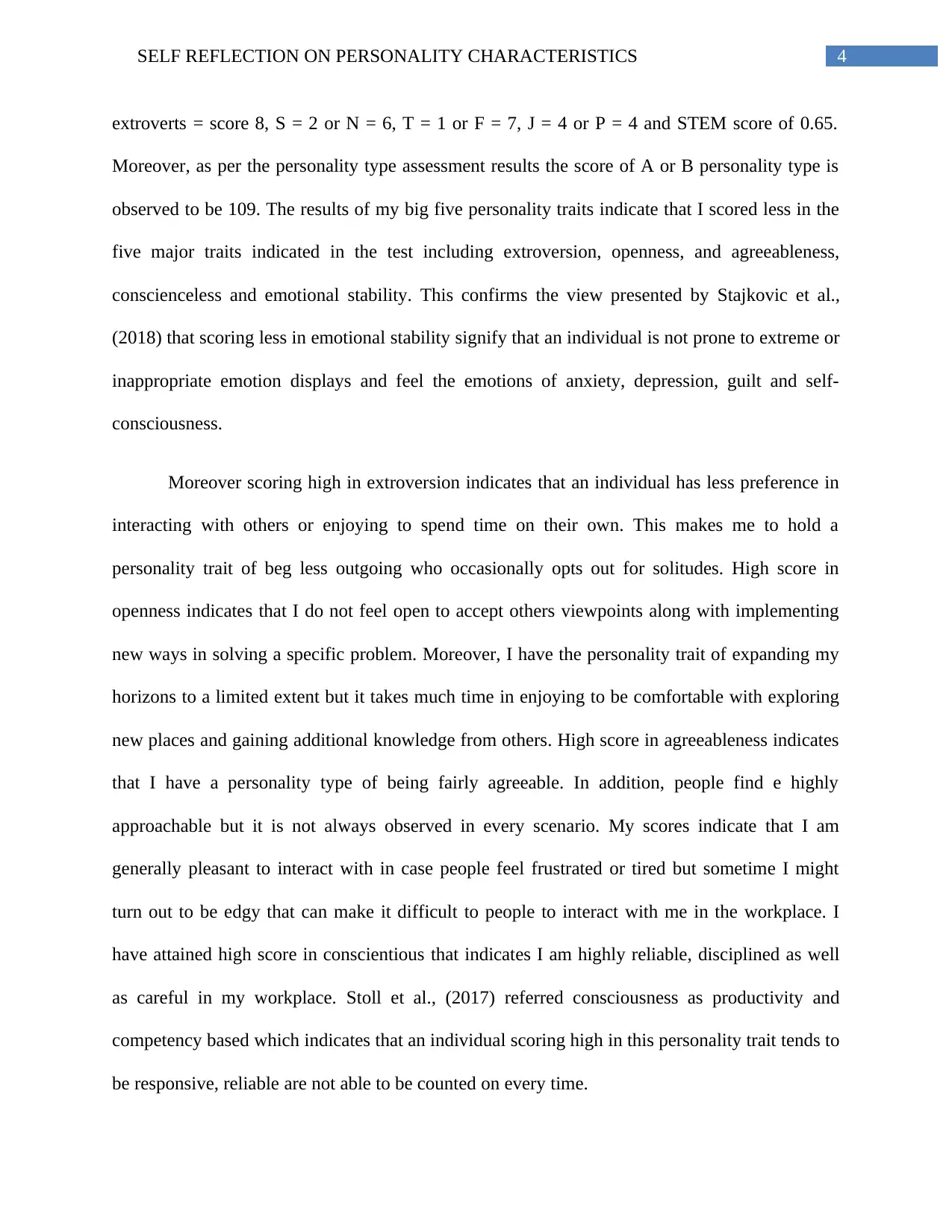
4SELF REFLECTION ON PERSONALITY CHARACTERISTICS
extroverts = score 8, S = 2 or N = 6, T = 1 or F = 7, J = 4 or P = 4 and STEM score of 0.65.
Moreover, as per the personality type assessment results the score of A or B personality type is
observed to be 109. The results of my big five personality traits indicate that I scored less in the
five major traits indicated in the test including extroversion, openness, and agreeableness,
conscienceless and emotional stability. This confirms the view presented by Stajkovic et al.,
(2018) that scoring less in emotional stability signify that an individual is not prone to extreme or
inappropriate emotion displays and feel the emotions of anxiety, depression, guilt and self-
consciousness.
Moreover scoring high in extroversion indicates that an individual has less preference in
interacting with others or enjoying to spend time on their own. This makes me to hold a
personality trait of beg less outgoing who occasionally opts out for solitudes. High score in
openness indicates that I do not feel open to accept others viewpoints along with implementing
new ways in solving a specific problem. Moreover, I have the personality trait of expanding my
horizons to a limited extent but it takes much time in enjoying to be comfortable with exploring
new places and gaining additional knowledge from others. High score in agreeableness indicates
that I have a personality type of being fairly agreeable. In addition, people find e highly
approachable but it is not always observed in every scenario. My scores indicate that I am
generally pleasant to interact with in case people feel frustrated or tired but sometime I might
turn out to be edgy that can make it difficult to people to interact with me in the workplace. I
have attained high score in conscientious that indicates I am highly reliable, disciplined as well
as careful in my workplace. Stoll et al., (2017) referred consciousness as productivity and
competency based which indicates that an individual scoring high in this personality trait tends to
be responsive, reliable are not able to be counted on every time.
extroverts = score 8, S = 2 or N = 6, T = 1 or F = 7, J = 4 or P = 4 and STEM score of 0.65.
Moreover, as per the personality type assessment results the score of A or B personality type is
observed to be 109. The results of my big five personality traits indicate that I scored less in the
five major traits indicated in the test including extroversion, openness, and agreeableness,
conscienceless and emotional stability. This confirms the view presented by Stajkovic et al.,
(2018) that scoring less in emotional stability signify that an individual is not prone to extreme or
inappropriate emotion displays and feel the emotions of anxiety, depression, guilt and self-
consciousness.
Moreover scoring high in extroversion indicates that an individual has less preference in
interacting with others or enjoying to spend time on their own. This makes me to hold a
personality trait of beg less outgoing who occasionally opts out for solitudes. High score in
openness indicates that I do not feel open to accept others viewpoints along with implementing
new ways in solving a specific problem. Moreover, I have the personality trait of expanding my
horizons to a limited extent but it takes much time in enjoying to be comfortable with exploring
new places and gaining additional knowledge from others. High score in agreeableness indicates
that I have a personality type of being fairly agreeable. In addition, people find e highly
approachable but it is not always observed in every scenario. My scores indicate that I am
generally pleasant to interact with in case people feel frustrated or tired but sometime I might
turn out to be edgy that can make it difficult to people to interact with me in the workplace. I
have attained high score in conscientious that indicates I am highly reliable, disciplined as well
as careful in my workplace. Stoll et al., (2017) referred consciousness as productivity and
competency based which indicates that an individual scoring high in this personality trait tends to
be responsive, reliable are not able to be counted on every time.
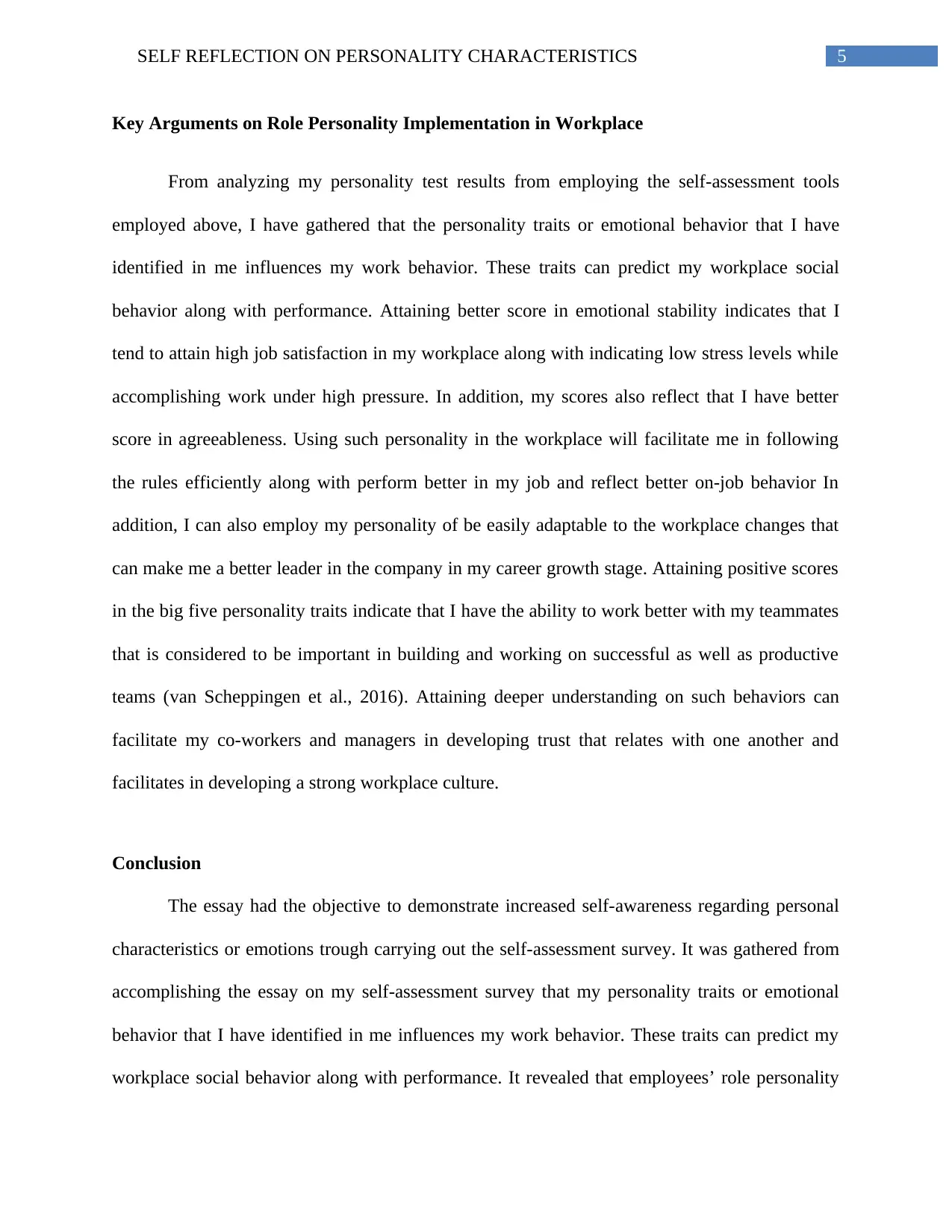
5SELF REFLECTION ON PERSONALITY CHARACTERISTICS
Key Arguments on Role Personality Implementation in Workplace
From analyzing my personality test results from employing the self-assessment tools
employed above, I have gathered that the personality traits or emotional behavior that I have
identified in me influences my work behavior. These traits can predict my workplace social
behavior along with performance. Attaining better score in emotional stability indicates that I
tend to attain high job satisfaction in my workplace along with indicating low stress levels while
accomplishing work under high pressure. In addition, my scores also reflect that I have better
score in agreeableness. Using such personality in the workplace will facilitate me in following
the rules efficiently along with perform better in my job and reflect better on-job behavior In
addition, I can also employ my personality of be easily adaptable to the workplace changes that
can make me a better leader in the company in my career growth stage. Attaining positive scores
in the big five personality traits indicate that I have the ability to work better with my teammates
that is considered to be important in building and working on successful as well as productive
teams (van Scheppingen et al., 2016). Attaining deeper understanding on such behaviors can
facilitate my co-workers and managers in developing trust that relates with one another and
facilitates in developing a strong workplace culture.
Conclusion
The essay had the objective to demonstrate increased self-awareness regarding personal
characteristics or emotions trough carrying out the self-assessment survey. It was gathered from
accomplishing the essay on my self-assessment survey that my personality traits or emotional
behavior that I have identified in me influences my work behavior. These traits can predict my
workplace social behavior along with performance. It revealed that employees’ role personality
Key Arguments on Role Personality Implementation in Workplace
From analyzing my personality test results from employing the self-assessment tools
employed above, I have gathered that the personality traits or emotional behavior that I have
identified in me influences my work behavior. These traits can predict my workplace social
behavior along with performance. Attaining better score in emotional stability indicates that I
tend to attain high job satisfaction in my workplace along with indicating low stress levels while
accomplishing work under high pressure. In addition, my scores also reflect that I have better
score in agreeableness. Using such personality in the workplace will facilitate me in following
the rules efficiently along with perform better in my job and reflect better on-job behavior In
addition, I can also employ my personality of be easily adaptable to the workplace changes that
can make me a better leader in the company in my career growth stage. Attaining positive scores
in the big five personality traits indicate that I have the ability to work better with my teammates
that is considered to be important in building and working on successful as well as productive
teams (van Scheppingen et al., 2016). Attaining deeper understanding on such behaviors can
facilitate my co-workers and managers in developing trust that relates with one another and
facilitates in developing a strong workplace culture.
Conclusion
The essay had the objective to demonstrate increased self-awareness regarding personal
characteristics or emotions trough carrying out the self-assessment survey. It was gathered from
accomplishing the essay on my self-assessment survey that my personality traits or emotional
behavior that I have identified in me influences my work behavior. These traits can predict my
workplace social behavior along with performance. It revealed that employees’ role personality
⊘ This is a preview!⊘
Do you want full access?
Subscribe today to unlock all pages.

Trusted by 1+ million students worldwide
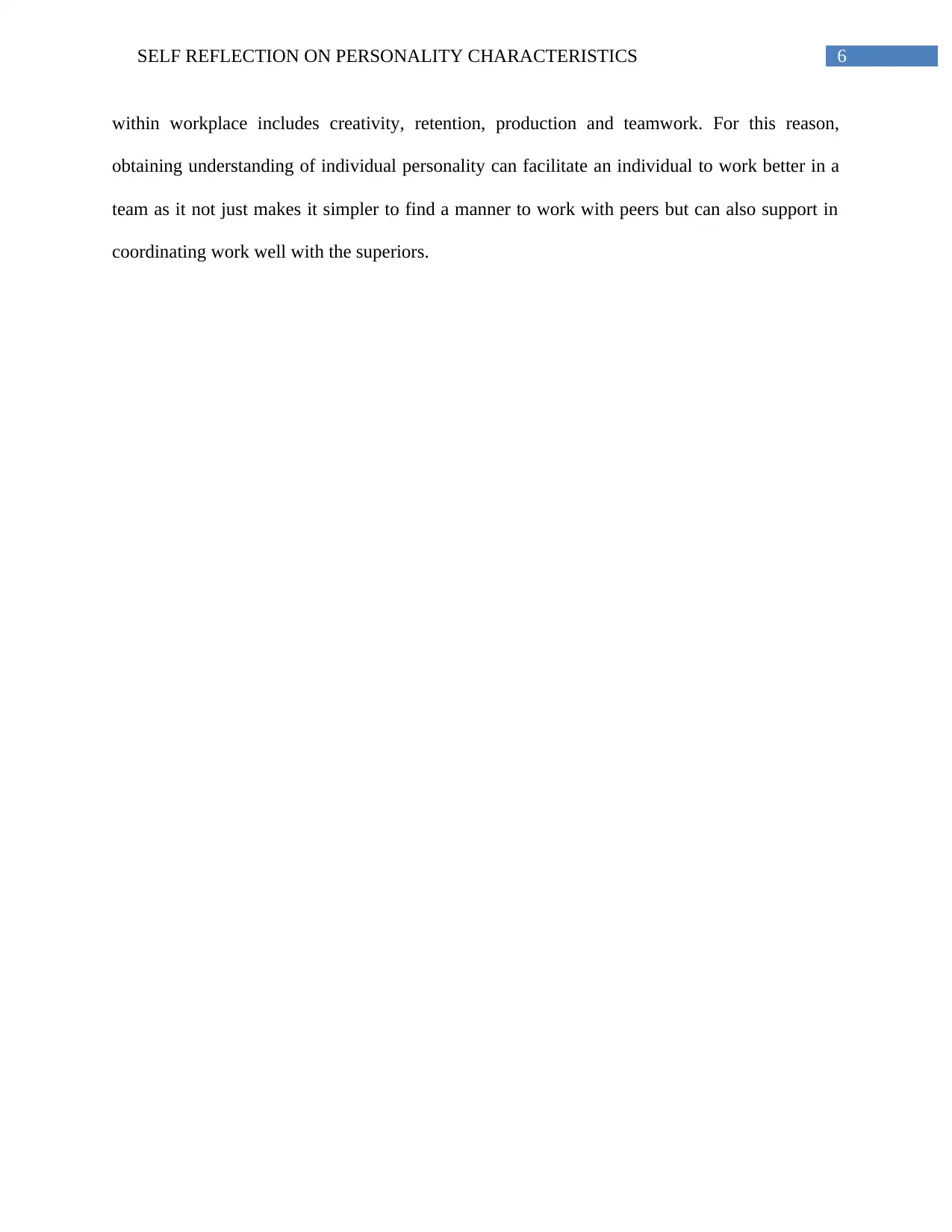
6SELF REFLECTION ON PERSONALITY CHARACTERISTICS
within workplace includes creativity, retention, production and teamwork. For this reason,
obtaining understanding of individual personality can facilitate an individual to work better in a
team as it not just makes it simpler to find a manner to work with peers but can also support in
coordinating work well with the superiors.
within workplace includes creativity, retention, production and teamwork. For this reason,
obtaining understanding of individual personality can facilitate an individual to work better in a
team as it not just makes it simpler to find a manner to work with peers but can also support in
coordinating work well with the superiors.
Paraphrase This Document
Need a fresh take? Get an instant paraphrase of this document with our AI Paraphraser
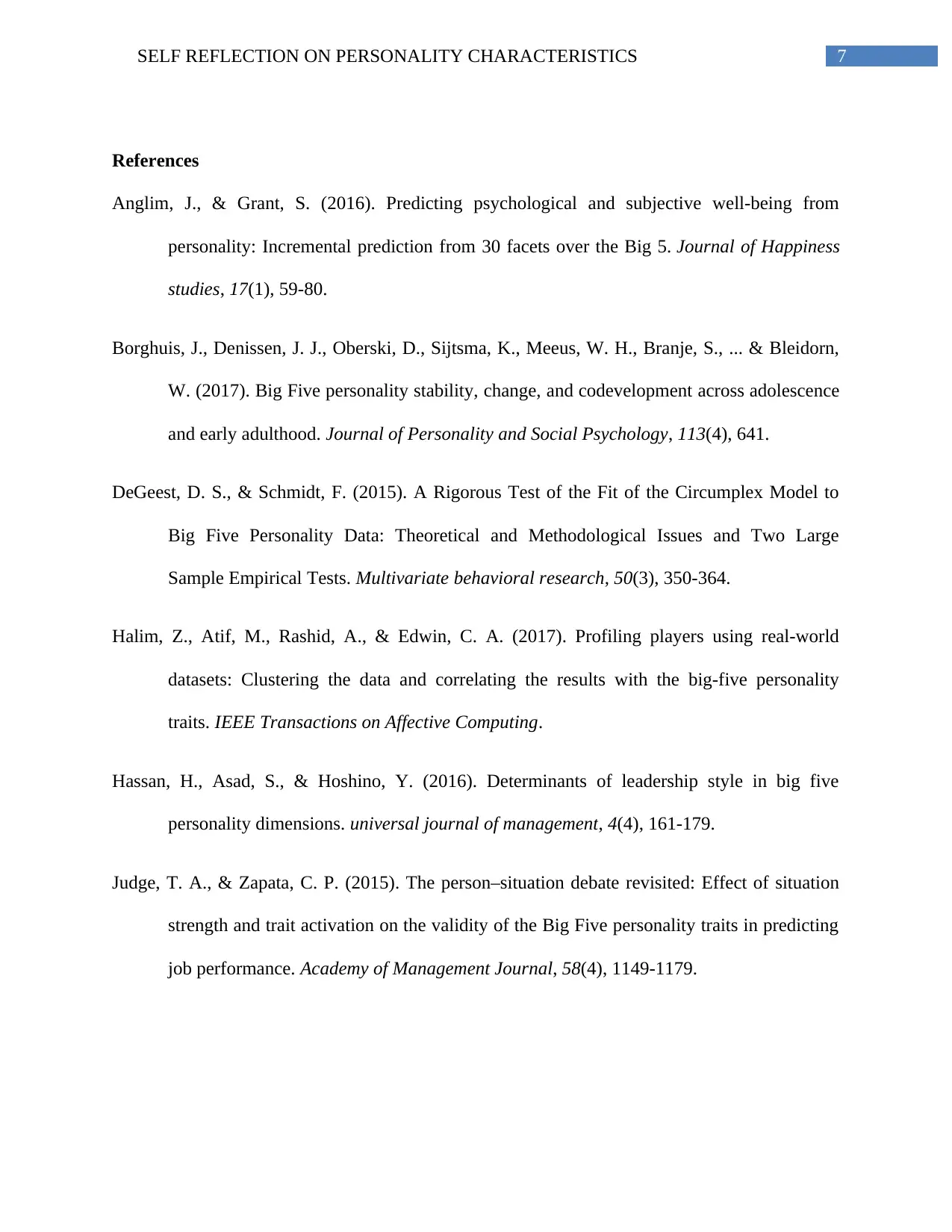
7SELF REFLECTION ON PERSONALITY CHARACTERISTICS
References
Anglim, J., & Grant, S. (2016). Predicting psychological and subjective well-being from
personality: Incremental prediction from 30 facets over the Big 5. Journal of Happiness
studies, 17(1), 59-80.
Borghuis, J., Denissen, J. J., Oberski, D., Sijtsma, K., Meeus, W. H., Branje, S., ... & Bleidorn,
W. (2017). Big Five personality stability, change, and codevelopment across adolescence
and early adulthood. Journal of Personality and Social Psychology, 113(4), 641.
DeGeest, D. S., & Schmidt, F. (2015). A Rigorous Test of the Fit of the Circumplex Model to
Big Five Personality Data: Theoretical and Methodological Issues and Two Large
Sample Empirical Tests. Multivariate behavioral research, 50(3), 350-364.
Halim, Z., Atif, M., Rashid, A., & Edwin, C. A. (2017). Profiling players using real-world
datasets: Clustering the data and correlating the results with the big-five personality
traits. IEEE Transactions on Affective Computing.
Hassan, H., Asad, S., & Hoshino, Y. (2016). Determinants of leadership style in big five
personality dimensions. universal journal of management, 4(4), 161-179.
Judge, T. A., & Zapata, C. P. (2015). The person–situation debate revisited: Effect of situation
strength and trait activation on the validity of the Big Five personality traits in predicting
job performance. Academy of Management Journal, 58(4), 1149-1179.
References
Anglim, J., & Grant, S. (2016). Predicting psychological and subjective well-being from
personality: Incremental prediction from 30 facets over the Big 5. Journal of Happiness
studies, 17(1), 59-80.
Borghuis, J., Denissen, J. J., Oberski, D., Sijtsma, K., Meeus, W. H., Branje, S., ... & Bleidorn,
W. (2017). Big Five personality stability, change, and codevelopment across adolescence
and early adulthood. Journal of Personality and Social Psychology, 113(4), 641.
DeGeest, D. S., & Schmidt, F. (2015). A Rigorous Test of the Fit of the Circumplex Model to
Big Five Personality Data: Theoretical and Methodological Issues and Two Large
Sample Empirical Tests. Multivariate behavioral research, 50(3), 350-364.
Halim, Z., Atif, M., Rashid, A., & Edwin, C. A. (2017). Profiling players using real-world
datasets: Clustering the data and correlating the results with the big-five personality
traits. IEEE Transactions on Affective Computing.
Hassan, H., Asad, S., & Hoshino, Y. (2016). Determinants of leadership style in big five
personality dimensions. universal journal of management, 4(4), 161-179.
Judge, T. A., & Zapata, C. P. (2015). The person–situation debate revisited: Effect of situation
strength and trait activation on the validity of the Big Five personality traits in predicting
job performance. Academy of Management Journal, 58(4), 1149-1179.
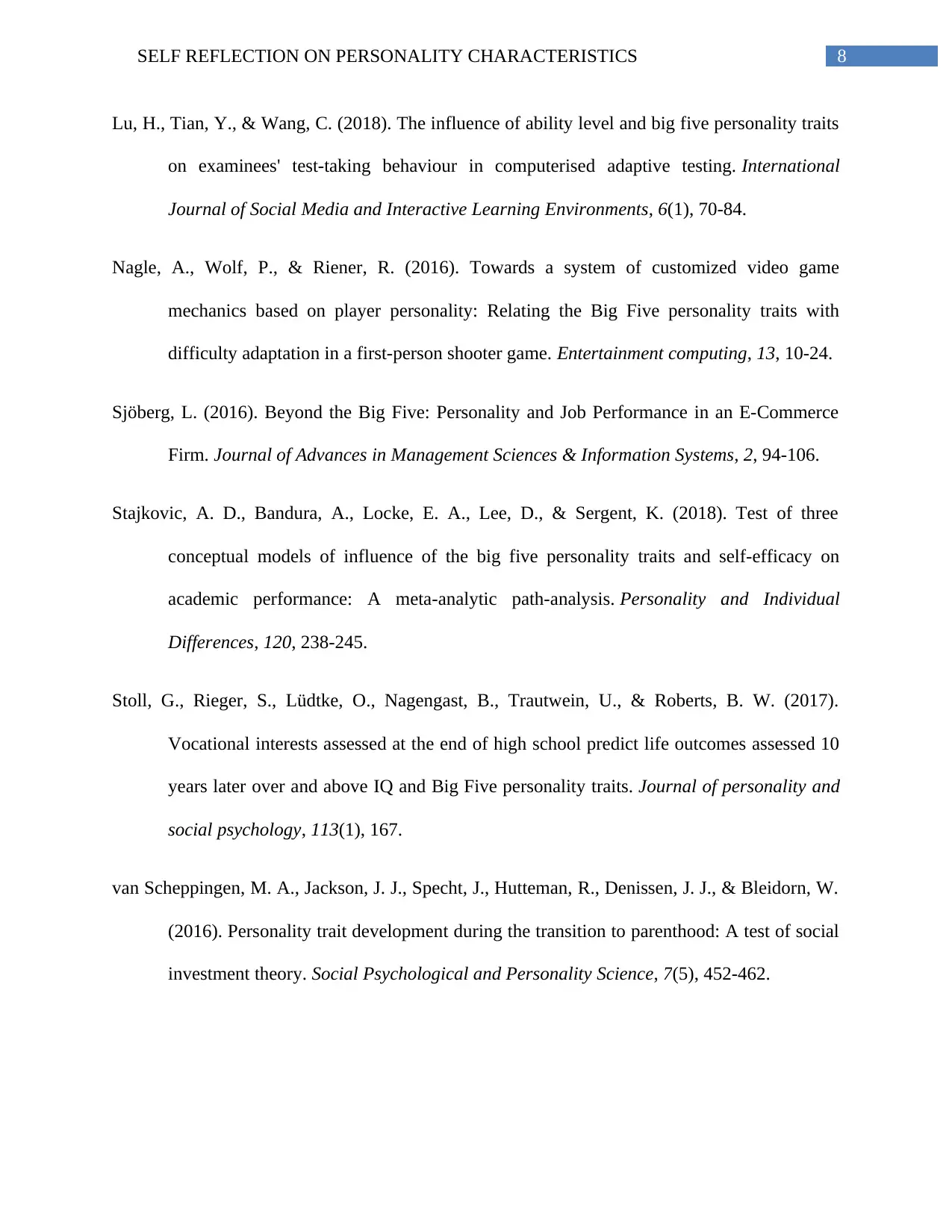
8SELF REFLECTION ON PERSONALITY CHARACTERISTICS
Lu, H., Tian, Y., & Wang, C. (2018). The influence of ability level and big five personality traits
on examinees' test-taking behaviour in computerised adaptive testing. International
Journal of Social Media and Interactive Learning Environments, 6(1), 70-84.
Nagle, A., Wolf, P., & Riener, R. (2016). Towards a system of customized video game
mechanics based on player personality: Relating the Big Five personality traits with
difficulty adaptation in a first-person shooter game. Entertainment computing, 13, 10-24.
Sjöberg, L. (2016). Beyond the Big Five: Personality and Job Performance in an E-Commerce
Firm. Journal of Advances in Management Sciences & Information Systems, 2, 94-106.
Stajkovic, A. D., Bandura, A., Locke, E. A., Lee, D., & Sergent, K. (2018). Test of three
conceptual models of influence of the big five personality traits and self-efficacy on
academic performance: A meta-analytic path-analysis. Personality and Individual
Differences, 120, 238-245.
Stoll, G., Rieger, S., Lüdtke, O., Nagengast, B., Trautwein, U., & Roberts, B. W. (2017).
Vocational interests assessed at the end of high school predict life outcomes assessed 10
years later over and above IQ and Big Five personality traits. Journal of personality and
social psychology, 113(1), 167.
van Scheppingen, M. A., Jackson, J. J., Specht, J., Hutteman, R., Denissen, J. J., & Bleidorn, W.
(2016). Personality trait development during the transition to parenthood: A test of social
investment theory. Social Psychological and Personality Science, 7(5), 452-462.
Lu, H., Tian, Y., & Wang, C. (2018). The influence of ability level and big five personality traits
on examinees' test-taking behaviour in computerised adaptive testing. International
Journal of Social Media and Interactive Learning Environments, 6(1), 70-84.
Nagle, A., Wolf, P., & Riener, R. (2016). Towards a system of customized video game
mechanics based on player personality: Relating the Big Five personality traits with
difficulty adaptation in a first-person shooter game. Entertainment computing, 13, 10-24.
Sjöberg, L. (2016). Beyond the Big Five: Personality and Job Performance in an E-Commerce
Firm. Journal of Advances in Management Sciences & Information Systems, 2, 94-106.
Stajkovic, A. D., Bandura, A., Locke, E. A., Lee, D., & Sergent, K. (2018). Test of three
conceptual models of influence of the big five personality traits and self-efficacy on
academic performance: A meta-analytic path-analysis. Personality and Individual
Differences, 120, 238-245.
Stoll, G., Rieger, S., Lüdtke, O., Nagengast, B., Trautwein, U., & Roberts, B. W. (2017).
Vocational interests assessed at the end of high school predict life outcomes assessed 10
years later over and above IQ and Big Five personality traits. Journal of personality and
social psychology, 113(1), 167.
van Scheppingen, M. A., Jackson, J. J., Specht, J., Hutteman, R., Denissen, J. J., & Bleidorn, W.
(2016). Personality trait development during the transition to parenthood: A test of social
investment theory. Social Psychological and Personality Science, 7(5), 452-462.
⊘ This is a preview!⊘
Do you want full access?
Subscribe today to unlock all pages.

Trusted by 1+ million students worldwide
1 out of 9
Related Documents
Your All-in-One AI-Powered Toolkit for Academic Success.
+13062052269
info@desklib.com
Available 24*7 on WhatsApp / Email
![[object Object]](/_next/static/media/star-bottom.7253800d.svg)
Unlock your academic potential
Copyright © 2020–2025 A2Z Services. All Rights Reserved. Developed and managed by ZUCOL.




